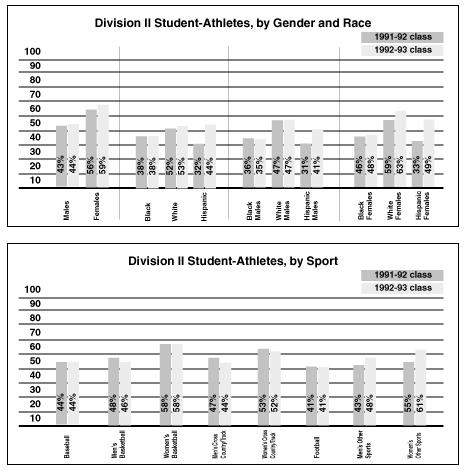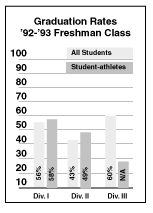The NCAA News - News and Features
The NCAA News -- August 30, 1999
Graduation rate shows slight increase in second report
 The second set of graduation rates for Division II student-athletes shows little overall change from the first study, which was compiled last year. The second set of graduation rates for Division II student-athletes shows little overall change from the first study, which was compiled last year.
The 1999 NCAA Divisions II and III Graduation-Rates Report, which was mailed to the membership in late August, shows that 49 percent of Division II student-athletes in the 1992-93 entering class graduated within six years. That is slightly higher than the 48 percent rate noted with the 1991-92 entering class. The graduation rate for the overall Division II student body jumped from 41 to 43 percent.
The student-athlete figures are based on athletes who receive athletically related financial aid. For that reason, Division III figures are available only for the overall student body, which graduated at a 60 percent rate for the second consecutive year.
Division II graduation rates are lower than those in Division I both for the overall student body and for the student population. However, institutional missions vary considerably from division to division, which may at least partially explain why the student-athlete rate is nine points higher (and the overall rate 13 points higher) in Division I than in Division II.
Todd A. Petr, NCAA director of research, noted that although Division II graduation rates are lower than they are in Division I, Division II student-athletes outperform their peers in the overall student body by a greater margin than they do in Division I (49 percent vs. 43 percent in Division II, 58 percent vs. 56 percent in Division I).
Petr noted that although no formal analysis accompanies the Division II and III report, it is possible that Division II may be the division that attempts to provide the greatest access to higher education. To achieve that goal, admission standards may be less restrictive, which in turn could lead to lower graduation rates.
"I think other factors also need to be considered," Petr said. "For instance, fewer athletes receive full grants-in-aid in Division II, which means they could face greater financial pressures in some cases."
 Division II female student-athletes continued to graduate at a much higher rate than their male peers. In the most recent report, they graduated at a 59 percent rate, compared to 44 percent for men. In the first study, women outperformed men 56 percent to 43 percent. Division II female student-athletes continued to graduate at a much higher rate than their male peers. In the most recent report, they graduated at a 59 percent rate, compared to 44 percent for men. In the first study, women outperformed men 56 percent to 43 percent.
The overall rate for black student-athletes remained at 38 percent, rising slightly for women (46 to 48 percent) and dropping a little for men (36 percent to 35 percent).
Hispanic rate rises
Perhaps the most interesting change from the first report involved the graduation rate for Division II Hispanic student-athletes. Although the group is rather small (192 men and 127 women) and may therefore be subject to fluctuation, the graduation rate for Hispanic student-athletes jumped from 32 to 44 percent from Year 1 to Year 2. The increase was a bit more pronounced for women than men.
In Division III, the overall graduation rate was 57 percent for men and 63 percent for women. White males posted a 60 percent figure while white females graduated at a 65 percent rate. The rates for Blacks were 36 percent for men and 43 percent for women.
The graduation-rate report is required by NCAA Bylaw 13.3.1 and the Federal Student Right-to-Know Act. Only student-athletes who enroll as freshmen, receive athletically related financial aid and who graduate from that institution within six years of initial enrollment are tracked. Student-athletes who transfer in good academic standing and who graduate elsewhere count against their original institution as not graduating. They also are not counted in the freshman cohort for their second institution.
Previously, a persistence-rate report was compiled for Divisions II and III institutions. That was because institutions at that level did not necessarily have the records needed to provide graduation information. The graduation reports for Divisions II and III had to be built from the ground up.
In addition to the aggregate data, the reports include graduation-rate information for every Division II and III institution.
|